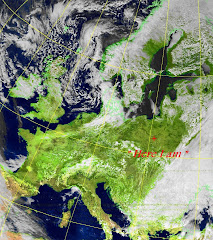Having achieved over the years considerable success with radio communication on the VHF bands using terrestrial modes of radio-signal propagation and reflecting my signals from the ionised trails formed by meteorites as they burn up in the earth's atmosphere, I am considering a new, formidable, challenge; reflecting my signals from the moon, to be able to contact amateur stations on the other side of the world on VHF. Signals received via the moon will be very weak, however, and at present noise may be a limiting factor. All radio signals are received in the presence of noise, from external atmospheric, man-made and galactic sources as well as that added by the receive equipment itself. Even an electronic component, such as a resistor, lying unconnected on the work-bench generates noise at the sub-atomic level, unless kept at a temperature of -273C ! Powered-up equipment at room-temperature is much noisier. I had been wondering if my equipment would be sensitive enough to receive signals reflected from the moon from other stations, as well as my own, or would they be buried under the noise and be undetectable.So I carried out an assessment of the noise performance of my VHF receive set-ups, for 50, 70 and 144MHz frequencies, and found it to be poor in each case. The noise is excessive for consistently successful 'moonbounce', though there is always the possibility of the occasional 'freak' contact. My assessment method, using my 144MHz set-up as the example, is shown in the upper picture.
I can't control external noise, but fortunately there is still a remedy; fit a low noise receive signal pre-amplifier as close to the antenna as possible. I set about designing one, first for 144MHz, based on a low noise n-channel dual gate mosfet transistor, type BF991, which is specified to 200MHz, ( circuit shown ). With a noise figure of 1.28dB and sufficient gain, this little amplifier should do nicely and allow a signal power of 1.306x10e-4 picowatts from the antenna to be detected with a signal / noise ratio of 10dB in a 2400Hz receiver bandwidth ! I will need to modify the circuit for the other two frequency bands mentioned, just by changing the attenuation of the 50 Ohm pad and the values of the frequency dependent components.
So three preamplifiers in all - my list of circuits to build during next winter just keeps growing !
-






